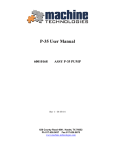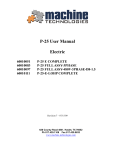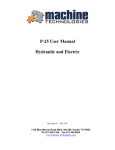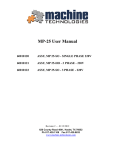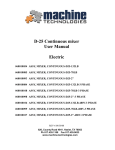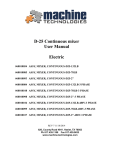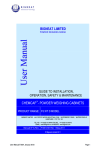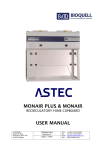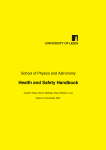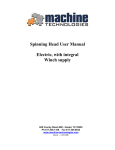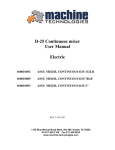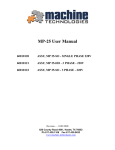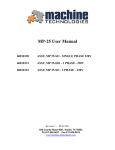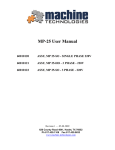Download P-15 User Manual 115V Electric (20A supply)
Transcript
P-15 User Manual 115V Electric (20A supply) 60010161 P-15 PUMP ASSY COMP 620 County Road 4841. Haslet, TX 76052 Ph 817.636.5637 Fax 817.636.5675 www.machine-technologies.com Dear Customer, Before starting this machine please complete the following; Machine Date of purchase………………………………….. Machine serial number……………………………………… Please read the following information contained within this manual and fully familiarize yourself with the equipment. Page 1 Contents Page Section 1 - General Safety information........................................................................... 3 Danger............................................................................................................................. 3 Section 2 - Machine Description ...................................................................................... 4 Function.......................................................................................................................... 4 Machine illustrations..................................................................................................... 5 Machine ....................................................................................................................... 5 Hopper unit................................................................................................................. 6 Front and rear seal location ...................................................................................... 7 Pump Unit ................................................................................................................... 8 Available pump assemblies........................................................................................ 9 Drive unit - complete................................................................................................ 10 Electronic drive unit................................................................................................. 11 Motor gearbox assembly.......................................................................................... 12 Electronic Drive module .......................................................................................... 13 Wired Remote unit ................................................................................................... 14 Section 3 – Transportation and positioning ................................................................. 15 Section 4 – Machine set up ............................................................................................. 16 Unpacking .................................................................................................................... 16 Machine assembly........................................................................................................ 17 Electrical connections .............................................................................................. 21 Section 5 – Machine start up / operation / Speed setting and Clean down................ 22 Machine start up.......................................................................................................... 22 Machine operation....................................................................................................... 24 Speed setting................................................................................................................. 26 Section 6 – Simple maintenance..................................................................................... 27 Front seal replacement................................................................................................ 28 Electronic drive module .............................................................................................. 29 Recommended fluids ................................................................................................... 30 Specific cleaning areas and instructions.................................................................... 30 Section 7 – Notes on wear of rotor / stator pump unit................................................ 31 Stator adjustment ........................................................................................................ 31 Wear issues................................................................................................................... 31 LIMITED WARRANTY POLICY .............................................................................. 32 Page 2 Section 1 - General Safety information Danger Follow these instructions very carefully, in order to avoid injury to yourself or others. Electrically powered machine. Always ensure that all power to the machine has been turned off and isolated before ANY maintenance / repair work is carried out on the machine. Ensure that all guards are correctly fitted before starting or attempting to operate the machine. Ensure that all fasteners are present and correctly fitted before attempting to start or operate the machine. Ensure that the pump unit is correctly fastened to the front of the hopper unit of the machine, and free of damage before attempting to start or operate the machine. The P-15 pump unit can produce high pressures, high torques and can generate high voltages. Authorized persons ONLY can use this machine, and must take care at all times. Page 3 Section 2 - Machine Description Function The machine has a drive motor, that turns a drive shaft within a material hopper that in turn feeds a progressive cavity rotor stator pump unit that delivers the material from the hopper to the dispense head via a material hose / hoses. The machine is driven by an electric motor powered by a 220VAC 3 phase supply, via an electronic variable speed inverter supplied by two-phase 115VAC 50/60 Hz, fused at 20A. The drive transmits its rotary action through a drive shaft equipped with bridge breakers, which help to mix and convey the material from the hopper towards the pump unit. The pump unit is a progressive cavity pump unit comprising of a helical rotating “rotor” with the rubber lined “stator”. As material is drawn / fed into the pump unit it is forced through a series of cavities that deform, causing the material to be moved from the hopper towards the outlet. Once the material has reached the outlet it is guided through an output flange assembly, into the dispense hose through to the hose outlet, where typically a spray nozzle is attached allowing, with the assistance of an auxiliary air supply, the material to be “sprayed” on to the substrate. A number of different devices can be fitted to the outlet of the tube for different means of application. For details of these different devices please contact your supplier of Machine-Technologies equipment or Machine-Technologies directly. Page 4 Machine illustrations Machine Page 5 Hopper unit Page 6 Front and rear seal location (non P-15 rotor stator illustrated) Page 7 Pump Unit “D” pump series – Theoretical delivery 39.5 ft³/hr @ 150 RPM **Outputs are theoretical and typically 25% higher than seen in practice. Outputs are also subject to material type, moisture levels, application method and as such testing should be performed to establish suitability. Page 8 Available pump assemblies 60010182 – D8-1.5 p-15 pump assembly Page 9 Drive unit - complete Page 10 Electronic drive unit Page 11 Motor gearbox assembly Note – GREASE ON A DAILY BASIS Page 12 Electronic Drive module The electronic Drive module comprises of a variable speed frequency inverter, allowing the use of 115VAC single phase to run the high torque 3 Phase gear motor. The unit is rated at 1.5 HP providing plenty of power to run the P-15 unit. The module is supplied with an input plug allowing immediate wiring into your own 115VAC 20amp rated outlet. The motor is supplied pre-wired plug into control box. The module has a main power isolator, a combined stop / start push button, a reverse switch, a speed control potentiometer, external, resettable over current trip, a large capacity cooling fan in addition to the fan fitted to the inverter, and a remote socket, providing the capability for remote operation via the wired remote. The remote “dummy plug” or the actual remote must be fitted in order for the machine to operate, without the start switch being held in all the time. An over temperature override button is provided to recover from an overheat condition, allowing the emptying of the hopper and clean down only. The machine must be allowed to cool to where normal operation can be resumed. Page 13 Wired Remote unit The wired remote is to allow the control of the pump from the application point of the operation. The unit is connected to socket on the front of the Electronic drive module and locked in placed using the metal clip attached to the socket. Connection can be made and broken during operation, but the machine will stop functioning when either the dummy plug is removed or when the wired remote plug is removed. Once re-attached then the start button on either the remote OR the drive module can be pressed and the pump will function. Caution – Ensure that if the remote is connected that the operator in control of wired remote function is aware of possible pump operation at the pump location. Caution – Ensure that the pump operator is aware that possible operation can be achieved by the operator in charge of the wired remote control. The pump is started by pressing of the toggle on the remote towards “start” and then released. The pump is stopped by pressing the toggle on the remote towards the “stop” and then released. Typically the remote mounted to a spray gun, and the control cable is tied to the hose at regular intervals, for protection, using tape or zip ties to ensure that the cable is not damaged or cut while in operation. Page 14 Section 3 – Transportation and positioning The machine is typically manually transported around the job site using the two carrying handles, and the wheels in a similar manner to a wheelbarrow. The handles swing vertically down and out of the way when not in use. If the machine is to be permanently positioned then they can be removed and stored for later replacement. Care should be taken when raising the front of the machine to ensure that the lower rear of the motor is not damaged. It is important to ensure that the cooling fan inside the motor fan shroud turns freely and that an un-restricted air flow exists Page 15 Section 4 – Machine set up Unpacking Remove the safety grid from the top of the machine by removing the 4 bolts, clips and washers. Remove the pump unit, pump wedges and the breaker bar from the hopper. Consult the final inspection record supplied in the packing for details of your machine and the items checked prior to shipment. Keep this document for your records. Page 16 Machine assembly Remove the “Drive unit complete” from the packaging and assemble to the rear of the hopper, ensure that the wedges are secured and in place. Page 17 Assemble the breaker bar into the hopper and engage one of the flat ends into the slot in the drive / hauling bracket at the end of the “drive unit complete”. Rotate the drive shaft by hand until the other flat end of the shaft aligns with the approximate position of the slot in the end of the rotor in the pump unit. Slide the pump unit towards the hopper, over the location shafts, locating the drive shaft into the end of the slot in the pump unit. Page 18 Ease the pump assembly into position, then assemble the two wedges into the slots. Manipulate the pump unit and the wedges until the pump flange is within 1/8” of the hopper flange, then drive the wedges into position until both flange faces are flush. Note: the drive shaft CAN become tight between the two drive slots during static assembly. Once the unit has been running the compressive force will be reduced or eliminated to within working limits. During pumping the compression will be present, during reverse the compression will be relieved and a clearance will be present. Important Replace the safety grid back onto the top of the hopper and secure using the 4 clips, bolts and washers. Operation of this machinery without the grid in place is prohibited. Page 19 The output of the P-15 pump unit is supplied with a male cam-lock style fitting which threads directly onto the output of the pump, giving a 25mm male connection The male connection then connects to the female connection of the hose Ensure that all faces are clean and free from dirt and debris, and that the seal in the female coupling is in good condition. Page 20 Electrical connections 1. Ensure that there is a suitable 20A rated, grounded outlet available. The use of GFCI equipped sockets is not recommended due to nuisance tripping due to the inverter drive. 2. Do not use extension cords if possible, as pump output ratings can reduce, giving intermittent operation, and other tripping and start failure problems. 3. Turn the main isolator OFF on the electronic drive module. 4. Ensure that the “dummy plug” or the wired remote (shown below) is connected to the front of the drive module. 5. Make sure that all persons are clear of the machine and that no hazards exist regarding the pump and its operation. 6. Connect the power cord to the 20A rated outlet. Page 21 Section 5 – Machine start up / operation / Speed setting and Clean down Machine start up. Never operate the machine with the Rotor and stator dry. • • Either finish the previous day by lubricating the R/S unit with spray silicon, or Fill or partially fill the P-15 hopper with water and a suitable lubricant (dish soap). Turn the main power isolator to ON, listen for the cooling fan to turn on and an initial faint “whistle”. A qualified individual qualified in the use of electro-mechanical equipment must conduct the following. Ensure that there are no persons close to the machine. Ensure that there are no obstructions in or around the machine. Turn the speed control knob to position 3 to 5 on the dial. • Press the start button and observe the machine to turn the drive shaft counter clockwise. PRESS THE STOP button, within 5 seconds or damage could result to the pump unit. Page 22 Note if the pump assembly has been stationary for a few days or longer, then the rotor will likely be stuck in the stator. During start up use the FWD / REV switch to “rock” the rotor back and forth in the stator in an attempt to break it free. If this does not happen within a few seconds then slacken the clamp bolts, and use the jacking screw Note the number of turns you turn the jacking screw, then once the unit is running, back of the screw the same number of turns to put you back at the point of origin, keeping the pressure output the same as the last time the unit was run. IMPORTANT Never turn the rotor within the stator when “dry”, as damage can easily result to the stator. Always use a lubricating media to help allow the rotor to turn within the stator (NEVER USE MINERAL OILS) Lubricants typically used would be dish soap and water, or a silicon based spray. Typically an automotive silicon spray, sprayed into the rotor stator at the very last point of clean up will result in easier start ups. The use of the “back and forth” movement using the FWD /REV switch is highly recommended to help in breaking free rotors. The pump turns in a counter-clockwise direction when viewed from the motor end of the hopper when pumping. Page 23 Machine operation The drive operates using a simple start stop button, a forward reverse switch and a speed control. The drive must have the remote connected to it or the “dummy plug” attached or the unit will not stay running when the start button is pressed. Press the start button to operate the machine is the normal pumping direction (drive shaft turns counter clockwise, when viewed from the fan end of the motor) Use the reverse function to change the direction of the drive shaft, and in turn the pump rotor. The reverse function can be changed at any time during operation, to depressurize the discharge hose or to help break free a seized stator. DO NOT run the machine in reverse for more than a few seconds, and the rotor will try to screw forwards towards causing extensive wear on the back out stop in the output nozzle. Use the speed control to regulate the output RPM of the pump rotor. Always run the unit as slow as is required to carry out the job. Excessive speed causes excessive wear! The unit will operate between 40 and 150 RPM, the minimum speed to ensure air flow across the motor and the drive cooling fins, maximum is a limitation of the drive and gearing. The unit requires full and clear air flow to the motor fan cowl. If restricted then the air movement may cause the motor and drive to increase above their recommended operating temperatures causing premature failure or shut down. The amp meter on the module indicates the input current being drawn, and should be kept to below 20 amps. The duty cycle of the machine depends on many variables, such as Current, RPM, Pumping pressure, pumping distance, hose size, type of material application, ambient temperature. In general the less work (lower pressures, lower current, shorter hose, bigger diameter hose) the pump has to do in higher temperatures the longer it will run before tripping or shutting down. The motor is equipped with a thermal shut down switch, which when activated due to excessive heat will shut the system down. If this happens during operation, then provision is made for temporary continuance to allow clean down of the machine before the material sets up. Temporary operation is enabled by holding down and continuing to hold the temperature override button, while pressing the normal start button. If the override button is released then the machine will stop. Hold down the override until the clean up is completed DO NOT override for more than 10 minutes. Once cleaned out then leave to cool down until normal operation can be achieved. Page 24 • • • • • • • • • • • • • • • • • • Grease hauling bracket / drive auger seal daily, with water resistant, corrosion inhibited grease via the grease cert in the motor flange. Lubricate the rotor and stator assembly with, water and dish soap solution in the hopper. For starting the pump, ensure that the speed control is at no more than half speed, and direction control is set to forward. Turn main power switch on. Push start button. Adjust speed to desired output. (don’t turn faster than needed). Do not let hopper run dry while pump is running. To stop machine push the stop button. If a hose plugs while pumping, reverse direction on pump to relieve line pressure. Never point hose towards personnel when pump is working. When cleaning the pump, do not remove grate while pump is running. Wash out hopper with water and let it run out of the hose. When the hopper is clean run foam balls through hose with clean water. Do not spray water in or on the control box. Control box should be wiped down with a damp rag. If access is required in to the hopper, disconnect power source before removing grate. Pump can be disassembled by removing wedges, this facilitates easier transport and final clean up. Pump is supplied with an adjustable stator. The sleeve can be tightened to bring working pressure back to normal range as the stator wears down. This should be done in small increments. Over tightening the stator will cause premature wear and heat up material. Always check hoses and cords for wear. The unit runs on high voltage and is capable of high pressures in the hoses. Page 25 Speed setting DO NOT RUN THE ROTOR AND STATOR DRY The following are to be completed by trained and experienced persons, familiar with the pumping system provided. 1. Connect a hose to the output coupler on the end of the pump unit. 2. Fill or partially fill the P-15 hopper with water and a suitable lubricant (dish soap). 3. Place the discharge end of the hose, into the hopper, making sure that the end cannot come into contact with the moving parts inside the hopper. 4. Turn on the machine in the FWD direction and observe fluid to be displaced from the hopper through the hose and then back to the hopper, in a recirculatory manner. 5. Using a suitable collection vessel and a stopwatch, time the volume discharged in a given period. Convert this amount displaced into gallons / minute. Compare this figure with your required figure and adjust the speed accordingly. Do not run the machine with water and lubricant for more than five minutes at a time or damage could result to the pump unit. Page 26 Section 6 – Simple maintenance The P-15 pump unit is very simple to maintain. By far the biggest part of maintenance of the P-15 machine is cleaning after a job. Failure to clean properly after use will damage seals, paint, and moving parts due to material build up causing wear. Pay particular attention, when cleaning, to the seals between the Rotor stator flange and the flange on the front of the hopper, to the seal between the motor mounting flange and the rear of the hopper, to the seal around the drive / hauling bracket fixed to the drive flange at the rear of the machine. Ensure that the seal between the hauling bracket and the motor is greased each day or after each clean down, with a water resistant, corrosion inhibiting, extreme pressure grease. Grease until a small amount of grease can be seen “oozing” from around the hauling bracket. Page 27 Front seal replacement The illustration shows the front seal, in a deformed state, as would be seen when full of grease and fitted over the hauling bracket / Drive auger. Take special note of the grease groove positions of the seal and of the adapter, in relation to the grease hole in the plate and the grease cert. The two grooves together give a path for the grease to get into the cavity. Grease using a high water resistant, high corrosion protection, and extreme pressure type grease, on a daily basis, or after each time the unit is cleaned down Page 28 Electronic drive module The electronic drive module has been designed not to be accessed during normal operation, and as such the lid is sealed using RTV silicon. If the lid screws are adjusted for any reason they must be resealed. The electronic drive module will operate in excess of 4 hours at a time in 100°F ambient temperatures at full load (20 amp input), if however the unit shuts down and will not respond to start commands, perform the following checks. Can the main system fan be heard, if not then there is no power to the unit of or the resettable fuse has tripped. Turn unit off, and leave for 1 minute, reset the fuse then power on again, and press start. If the unit will still not operate then hold down the over temperature override button and press the start button, the unit should now operate. NOTE – the over ride button is for temporary operation to allow clean up of an overheated machine, and must not be used as normal operation. If the override button is released for any reason the unit will stop, and the override will have to be pressed and held and the start will have to be pressed once again. The unit is water resistant under the normal operation to “falling water”, rain and light hosing. It is not resistant to water spray, jets or water directed from anywhere other than directly above. The fan cowls are open on the underside to allow air to pass, and will not prevent entry of any liquids bouncing or prayed up into them. Water in the unit WILL result in damage. Free air flow must be allowed around both the cowls or overheating of the drive might result. Page 29 Recommended fluids Front seal grease – generic multi purpose grease with high water resistance, and rust/corrosion protection. No load bearing or high temperature properties required. Stator lubricants – generic dish soap mixed with water - typically 1 to 2 oz / gallon placed in hopper prior to rotating the rotor. Can be applied with a trigger spray bottle for assistance in starting in a dry hopper. Apply neat dish soap for new assembly of rotor in stator, but only if to be used within 4 hours. Silicon trigger spray – non propellant (preferred) applied during final few revs of clean up, leaving a reduced start up condition at restart. – can also be used as new assembly lubricant Silicon spray – automotive style propellant (limit amount used due to solvent content), applied as above, can also be used as new assembly lubricant. Specific cleaning areas and instructions During clean up pay specific attention to the areas around the motor seal and the pump seal at either end of the hopper. Strip down the Pump assembly, and ensure that the output nozzle is clear of build up. Grease the pump assembly draw bars and nuts with grease at re-assembly. Ensure that the stator is centered correctly in both the holes at either end, location is important. Always remove the drain cap from the hopper base during clean down to drain the remaining water etc. from the hopper. Failure to do so will result in a blocked drain port due to material remains setting up in the hole. Wipe down and clean the electronic drive module using a damp cloth and light amounts of water. ONLY clean down the drive model with the power off or the fan can draw in moisture. Once cleaned down, turn on the drive module and leave for approx 5 minutes to help circulate fresh air through it., store in an open and dry environment to minimize corrosion. Page 30 Section 7 – Notes on wear of rotor / stator pump unit A Rotor is the metal corkscrew looking item that ROTates inside the Stator. A Stator is the STATionary part that the rotor rotates inside. Stator adjustment Some of the Stators supplied are adjustable, some are not. The adjustable units allow the tightening of some bolts, to squeeze together two flanges, which in turn reduce the diameter of the inside of the stator, allowing a tighter fit around the rotor giving renewed ability to produce higher pressures, similar to when the unit was new. D8-1.5 ILLUSTRATED Wear issues Dry running of a rotor-stator pump A screw pump can only work reliably if there is adequate and appropriate lubrication. The lubricant reduces the friction between the rotor and the stator. If this lubricating film is damaged, high temperatures are reached and the elastomer wears within a very short time. Even if dry running lasts only a few seconds with new parts, the effect resembles that of a wheel spin on a car tire, dramatically affecting length of service. The use of simple dish soap, specific water based lubricants mixed with water while hose cleaning, or pump priming can dramatically reduce the negative effects of dry running, and help prolong the natural life of the rotor and stator. The use of silicon spray into the rotor and the stator can dramatically help start up. Please note. that rotor stator wear is directly related to the amount of work that the unit has to perform. A low-pressure job with a smooth mix will cause less wear than a highpressure job with smooth mix. A low-pressure job with a course mix will wear more than a low-pressure job with a smooth mix. The life of a rotor stator combo will need to be determined on a job-by-job basis, being dependent upon the coarseness of the mix and the amount of pressure required. Page 31 LIMITED WARRANTY POLICY Machine Technologies warrants each of its new machines to be free of defects in material and workmanship under normal use and services for a period of one (1) year from the date of delivery. The warranty is issued ONLY to the INITIAL USER. The warranty period begins when the product is delivered to the initial user or when first put into service, whichever occurs first. Said warranty is void if the machine is subject to misuse, neglect, accident or abuse. Machine Technologies’ obligation under this warranty is limited to correcting without charge, at its warehouse, any parts or parts thereof which shall be returned to its warehouse, transportation/shipping prepaid and upon Machine Technologies’ examination proves to have been originally defective. Correction of such defects by repair or replacement shall constitute fulfillment of all obligations to the initial user. This warranty does not include labor or transportation charges unless specifically identified and authorized in writing by Machine Technologies. Nor does the warranty apply to any unit upon which repairs or unauthorized alterations have been made. The warranty does not apply to normal maintenance service or to normal replacement of certain machine parts which are subject to normal wear (including but not limited to pins, bushings, rotors, stators, hoses, spray caps, spray nozzles, mixing shafts, shaft couplings and connectors, dosing shafts, pump shafts, filter elements and tires). THIS IS A LIMITED WARRANTY AND IS IN LIEU OF ANY OTHER WARRANTIES, EXPRESSED OR IMPLIED, INCLUDING ANY WARRANTY OF MERCHANTABILITY OF FITNESS FOR A PARTICULAR PURPOSE. In no event shall Machine Technologies be made liable for incidental, general or consequential damage, loss or any expense directly or indirectly related and resulting from use or lack of use caused by delay in delivery, parts failure, or any other causes associated with the product use. No person, firm or corporation is authorized to assume for Machine Technologies any other liability in connection with the sale of Machine Technologies products. Page 32

































